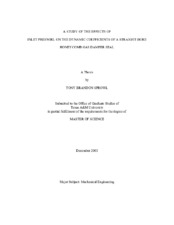| dc.description.abstract | In high-pressure centrifugal compressors, honeycomb seals are often used as replacements for labyrinth seals to enhance dynamic stability. A concern exists with the loss of this enhanced stability if the honeycomb cavities become clogged with debris over time. So, as a first objective, static and dynamic tests were conducted on a constant-clearance honeycomb and a constant-clearance smooth-bore seal under three inlet preswirl conditions to determine the effects of inlet preswirl. The resulting leakage flowrate and dynamic parameters, effective stiffness and damping of the seal, were measured for each seal and then compared, with the smooth-bore seal representing the honeycomb seal with completely clogged cells. The second objective was to evaluate a two-control volume theory by Kleynhans and Childs with the measured data under the influence of preswirl.
Both seals have a 114.7mm bore with a radial clearance of 0.2mm from the test rotor. The honeycomb seal has a cell width of 0.79mm and cell depth of 3.2mm. The target test matrix for each preswirl setting consisted of three exit-to-inlet pressure ratios of 15%, 35%, and 50%, and three rotor speeds out to 20,200 rpm. The target inlet air pressure was 70 bar-a.
Experimental results show that, for a clean honeycomb seal, preswirl has little effect on effective stiffness, Keff*, and decreases effective damping, Ceff*, by about 20% at the high inlet preswirl ratio (~0.6). However, comparing smooth and honeycomb seal results at higher inlet preswirl shows a potential reduction in Keff* by up to 68%, and a large drop and shift in positive Ceff* values, which could cause an instability in the lower frequency range. Measured leakage shows a potential increase of about 80%, regardless of test conditions. A swirl brake at the seal entrance would fix this loss in stability by significantly reducing inlet preswirl.
The two-control-volume theory model by Kleynhans and Childs seems to follow the frequency-dependent experimental data well for the honeycomb seal. Theory predicts conservatively (under-predicts) for stability parameters such as k* and Ceff* and for leakage. Predictions for K and Keff may possibly be improved with better measured friction factor coefficients for each seal. | en |


